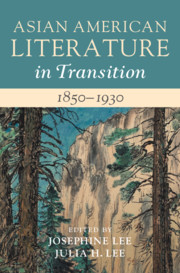Book contents
- Asian American Literature in Transition, 1850–1930
- Asian American Literature in Transition
- Asian American Literature in Transition, 1850–1930
- Copyright page
- Contents
- Illustrations
- Notes on Contributors
- Series Preface
- Introduction: Asian American Literature in Transition, 1850–1930
- Part I Empire and Resistance
- Part II Bodies at Work and Play
- Part III Crossings
- Chapter 12 Affect and Form in the Writings of the Eaton Sisters
- Chapter 13 Osato-san’sHands
- Chapter 14 Revolutionary Formalisms
- Chapter 15 Slave to Love
- Chapter 16 Anna May Wong’s Greetings to the World
- Bibliography
- Index
Chapter 13 - Osato-san’s Hands
Untimely Tales Gesture to Humanity’s Horizons
from Part III - Crossings
Published online by Cambridge University Press: 27 May 2021
- Asian American Literature in Transition, 1850–1930
- Asian American Literature in Transition
- Asian American Literature in Transition, 1850–1930
- Copyright page
- Contents
- Illustrations
- Notes on Contributors
- Series Preface
- Introduction: Asian American Literature in Transition, 1850–1930
- Part I Empire and Resistance
- Part II Bodies at Work and Play
- Part III Crossings
- Chapter 12 Affect and Form in the Writings of the Eaton Sisters
- Chapter 13 Osato-san’sHands
- Chapter 14 Revolutionary Formalisms
- Chapter 15 Slave to Love
- Chapter 16 Anna May Wong’s Greetings to the World
- Bibliography
- Index
Summary
This chapter proposes a framework of gestural analysis to read the untimely qualities of Nagahara Shōson’s serialized novel Osato-san [The Tale of Osato]. Osato-san was first published from 1925 to 1926 in the Rafu Shimpo, a Japanese-language newspaper in Los Angeles; an English translation was published in 2012. In the first half of the chapter I situate gestural analysis between the historical horizons of, on the one hand, recent turns to the aesthetics of gesture in Asian American literary and performance scholarship, and on the other, late nineteenth- and early twentieth-century attitudes toward gesture as exemplary of forms of “ethnic style” opposed to standardization and mechanization. The second half of the chapter demonstrates how the analysis of gesture can illuminate qualities of untimeliness across multiple temporal layers: from the horizon of expectations laid out by a Rafu Shimpo review of an earlier Shōson novel, through untimely temporal disturbances in the serial production of Osato-san, to shifts described in the closing horizons of the novel itself.
Keywords
- Type
- Chapter
- Information
- Asian American Literature in Transition, 1850–1930 , pp. 227 - 244Publisher: Cambridge University PressPrint publication year: 2021

